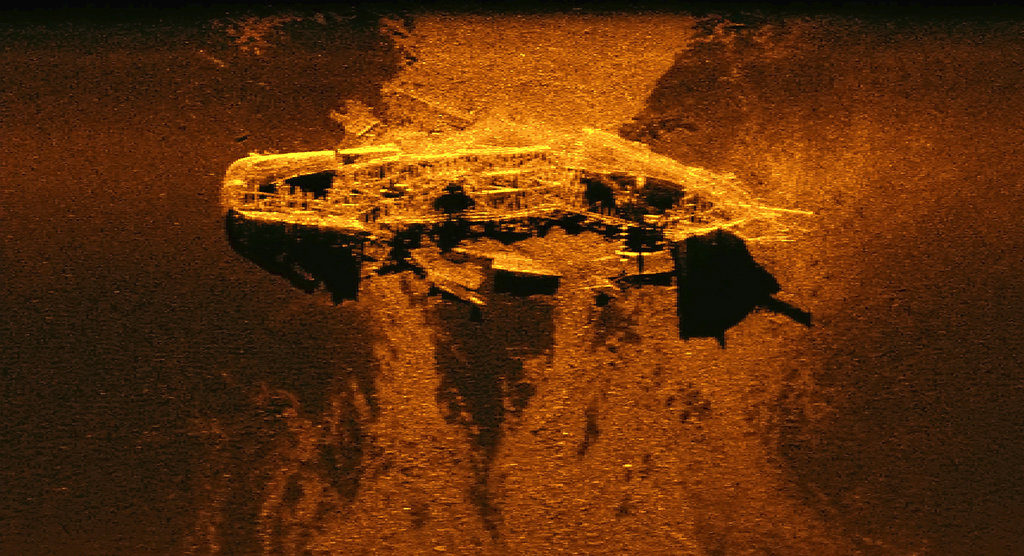Historians name 2 Indian Ocean 19th century shipwrecks

This undated image provided by the Australian Transport Safety Bureau shows debris of a ship that maritime historians say on Thursday, May 3, 2018, may be on a short list of the possible identities found during the initial 710,000-square kilometer (274,000-square mile) three-year search for Malaysia Airlines Flight 370 that was lost in 2014 with 238 people aboard. The wreckage is possibly the brig W. Gordon or the barque Magdala, according to incomplete records of ships lost in that period. (ATSB via AP)
CANBERRA, Australia — A four-year search of the depths of the Indian Ocean has failed to find Malaysia Airlines Flight 370. But the unprecedented sonar hunt for the missing airliner might be close to solving 19th century mysteries — the locations of two sailing ships that vanished with cargos of coal.
Maritime historians published on Thursday a short list of the possible identities of two shipwrecks found during the initial 710,000-square kilometer (274,000-square mile) three-year search for the Boeing 777 that was lost in 2014 with 238 people aboard.
The wrecks, found in 2015, are 36 kilometers (22 miles) apart and 2,300 kilometers (1,440 miles) southwest of Australia in debris fields scattered with coal more than 3.7 kilometers (2.3 miles) below the ocean’s surface.
The searchers had a closer look with underwater drones that took photographs of both sites and retrieved a coal sample from one. Analysis showed the coal was probably from Britain, a Western Australian Museum report said.
The museum’s examination of the images of the scattered remnants of a wooden ship discovered on May 19, 2015 found it was possibly the brig W. Gordon or the barque Magdala, according to incomplete records of ships lost in that period.
W. Gordon was on a voyage from Scotland to Australia when it disappeared in 1877 with 10 crew aboard. Magdala was lost in 1882 while sailing from Wales to Indonesia.
The report found the splintered wreck was most likely sunk by an explosion. Coal cargoes in the era exploded through sparking of methane gas accumulating below deck or the spontaneous combustion of overheated coal.
An iron wreck found on December 19, 2015, was most likely the barque West Ridge, which vanished while sailing from England to India with 28 sailors in 1883, the report said. A coal sample from that wreck suggested the cargo was British.
There was no evidence of what caused the disaster but the wreck’s location east of the trade route from Europe to Asia suggested it might have been heading to the closest port in Australia for help.
The museum’s curator of maritime archaeology, Ross Anderson, said new data about the two sinkings were a significant byproduct of the search for Flight 370, which was flying from Malaysia to China when communications with it were lost.
But Anderson doubted that the identities of the two deepest wrecks found in the Indian Ocean would ever be confirmed without a wealthy private benefactor because of their depth and remoteness.
“If it was a shipwreck that we could dive on … we’d be looking for any artifacts like ceramics or bottles or anything that could confirm providence,” Anderson said.
“These are the deepest wrecks so far located in the Indian Ocean, they’re some of the most remote shipwrecks in the world, so we try to maximize any information,” he added.
The initial underwater sonar probe scoured remote seabed at depths of up to 6,000 meters (20,000 feet) before Malaysia, China and Australia agreed to end the state-funded search for Flight 370 last year. The wrecks were found during that search.
The wrecks of two trawlers that sunk in the late 20th century were also discovered but the Australian Transport Safety Bureau, which supervised the search, did not ask the museum to research them.
Ocean Infinity, a United States technology company conducting a new search, said this week it had covered nearly 80,000 square kilometers (31,000 square miles) since January without finding any sign of the plane’s wreckage.
In January, the Malaysian government pledged to pay Texas-based Ocean Infinity up to $70 million if it could find the wreckage or black boxes of the aircraft within 90 days. /kga